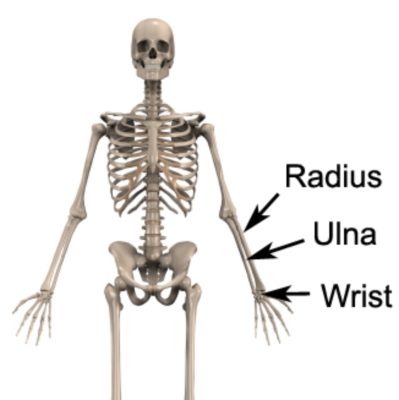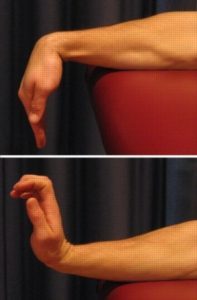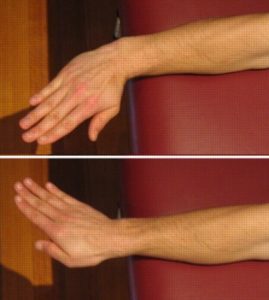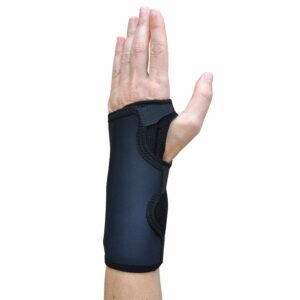Sprained Wrist
Updated:
(Also known as Wrist Sprain)
What is a sprained wrist?
A sprained wrist is a relatively common condition characterized by damage or tearing of the connective tissue (such as ligaments, cartilage and joint capsule) of the wrist.
The wrist comprises the joining of 8 small bones in the hand and the two bones of the forearm (radius and ulna) (figure 1). Between the wrist bones lie many small joints, each of which comprises of strong connective tissue wrapping around the bony ends and cartilage which lies between the joint surfaces, cushioning the impact of one bone on another during activity.

During certain movements of the wrist, stretching or compression forces are placed on the joints of the wrist. If these forces are excessive due to too much repetition or high force, injury to the joints may occur. This may involve damage to the cartilage or tearing to the connective tissue surrounding the joint. When this occurs, the condition is known as a sprained wrist.
Causes of a sprained wrist
A sprained wrist most commonly occurs due to a specific incident such as a fall onto an outstretched hand. This may occur with any fall, but is particularly common in sports such as cycling, skateboarding or snowboarding (particularly in icy conditions) where a fall onto a hard surface is unforgiving. A wrist sprain may also occur during weight lifting or boxing particularly in those with poor lifting or punching technique. Occasionally, a sprained wrist may occur due to repetitive strain associated with overuse. This may be the case in patients who perform heavy manual work involving the wrist such as the repetitive use of a hammer or screw driver.
Signs and symptoms of a sprained wrist
Patients with a sprained wrist often experience a sudden onset of wrist pain during the causative activity. However, patients may also experience pain and stiffness after the provocative activity, particularly the next morning. Symptoms may be felt on the front, back or sides of the wrist. Occasionally pain may be referred into the forearm or hand on the affected side. Symptoms are generally exacerbated with heavy activities that involve use of the hand and wrist such as opening jars or doors, picking up heavy objects, general gripping activity or placing weight through the affected hand (e.g. doing push-ups). It is also common for patients to experience pain on firmly touching the affected region, and, in some cases, a feeling of weakness in the wrist and hand may also be present.
Diagnosis of a sprained wrist
A thorough subjective and objective examination from a physiotherapist is usually sufficient to diagnose a sprained wrist. Investigations such as an X-ray, MRI or CT scan may be required to assist diagnosis and rule out other injuries (particularly fractures).
Treatment for a sprained wrist

Members Only ContentBecome a PhysioAdvisor Member to gain full access to this exclusive content. For more details see Become a Member. Already a member? Login Now
Prognosis of a sprained wrist
In cases of a minor to moderate wrist sprain, return to sport or normal activity can usually occur in 2 – 6 weeks with appropriate management and treatment. Patients with a more severe injury will usually require a longer period of rehabilitation to gain optimum function.
Physiotherapy for a sprained wrist
Physiotherapy for a sprained wrist can hasten the healing process, ensure an optimal outcome and reduce the likelihood of recurrence. Treatment may comprise:
- soft tissue massage
- electrotherapy (e.g. ultrasound)
- anti-inflammatory advice
- joint mobilization
- dry needling
- wrist taping
- wrist bracing
- ice or heat treatment
- exercises to improve flexibility and strength
- education
- activity modification advice
- a gradual return to activity program
Other intervention for a sprained wrist
Despite appropriate physiotherapy management, a small percentage of patients with a wrist sprain do not improve adequately. When this occurs the treating physiotherapist or doctor can advise on the best course of management. This may involve further investigations such as an X-ray, ultrasound, CT scan or MRI, pharmaceutical intervention, corticosteroid injection or a review with a specialist who can advise on any procedures that may be appropriate to improve the condition.
Exercises for a sprained wrist
The following exercises are commonly prescribed to patients with this condition. You should discuss the suitability of these exercises with your physiotherapist prior to beginning them. Generally, they should be performed 3 times daily and only provided they do not cause or increase symptoms.
Your physiotherapist can advise when it is appropriate to begin the initial exercises and eventually progress to the intermediate and advanced exercises. As a general rule, addition of exercises or progression to more advanced exercises should take place provided there is no increase in symptoms.
Initial Exercises
Wrist Bends
Begin this exercise with your forearm supported by a table or bench and your wrist and fingers over the edge (figure 2). Slowly bend your wrist forwards and backwards as far as you can go without pain and provided you feel no more than a mild to moderate stretch. Repeat 10 times provided there is no increase in symptoms.

Wrist Rotations
Begin this exercise with your elbow at your side and bent to 90 degrees (figure 3). Slowly rotate your palm up and down as far as you can go without pain and provided you feel no more than a mild to moderate stretch. Repeat 10 times provided there is no increase in symptoms.

Wrist Side Bends
Begin this exercise with your forearm supported by a table or bench and your wrist and fingers over the edge (figure 4). Slowly bend your wrist from side to side as far as you can go without pain and provided you feel no more than a mild to moderate stretch. Repeat 10 times provided there is no increase in symptoms.

Intermediate Exercises

Members Only ContentBecome a PhysioAdvisor Member to gain full access to this exclusive content. For more details see Become a Member. Already a member? Login Now
Advanced Exercises

Members Only ContentBecome a PhysioAdvisor Member to gain full access to this exclusive content. For more details see Become a Member. Already a member? Login Now
Rehabilitation Protocol for a sprained wrist

Members Only ContentBecome a PhysioAdvisor Member to gain full access to this exclusive content. For more details see Become a Member. Already a member? Login Now
 Physiotherapy products for a sprained wrist
Physiotherapy products for a sprained wrist
Some of the most commonly recommended products by physiotherapists to hasten healing and speed recovery in patients with this condition include:
To purchase physiotherapy products for a wrist sprain click on one of the above links or visit the PhysioAdvisor Shop.
 Find a Physio for a sprained wrist
Find a Physio for a sprained wrist
Find a Physiotherapist in your local area who can treat this condition.
 More information
More information
- Wrist Strengthening Exercises.
- Wrist Flexibility Exercises.
- Learn about when to use Ice or Heat.
- View detailed information on initial injury management and the R.I.C.E. Regime.
- Learn about Wrist Taping.
- Read our Wrist Diagnosis Guide.
Become a PhysioAdvisor Member

Link to this Page
If you would like to link to this article on your website, simply copy the code below and add it to your page:
<a href="https://physioadvisor.com.au/injuries/wrist-hand/sprained-wrist”>Sprained Wrist – PhysioAdvisor.com</a><br/>A sprained wrist (or wrist sprain) is a relatively common condition characterised by damage or tearing of the connective tissue or cartilage of the wrist.
Return to the top of Sprained Wrist.









